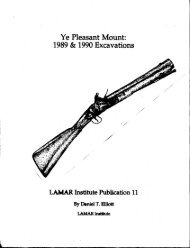Stirring Up a Hornet's Nest: - UGA Laboratory of Archaeology ...
Stirring Up a Hornet's Nest: - UGA Laboratory of Archaeology ...
Stirring Up a Hornet's Nest: - UGA Laboratory of Archaeology ...
Create successful ePaper yourself
Turn your PDF publications into a flip-book with our unique Google optimized e-Paper software.
ullets that struck organic targets that left the battlefield, this leaves 12,344 bullets on the battlefield. Using<br />
this estimate, the present survey again recovered about one-half <strong>of</strong> one percent <strong>of</strong> the bullets fired in the<br />
battle.<br />
If we use Colonel Dooly’s estimate <strong>of</strong> 200 guns fired by the opposing Loyalists at a rate <strong>of</strong> twice a minute<br />
for one hour, then this would have generated 24,000 bullets. If one figures that the firing rate during the<br />
other two hours <strong>of</strong> battle was one third <strong>of</strong> that, then the Loyalists may have fired as many as 39,840 bullets.<br />
And if one uses the same rate <strong>of</strong> hourly fire for the Patriots, then this would have generated another 7,920<br />
bullets, or a total <strong>of</strong> 47,760 bullets. Even if Dooly’s estimates were inflated by two thirds, that still leaves<br />
15,761 bullets. Compared to Dooly’s estimate <strong>of</strong> 47,760, the other estimates ranging between about 13,000<br />
and 54,000 bullets are probably not too far <strong>of</strong>f the mark. An average <strong>of</strong> the two extremes provides us with<br />
an estimate <strong>of</strong> 36,588 bullets fired in battle, then deduct the 10 percent removed from the battlefield by the<br />
participants (n=3,293) and that leaves 32,929 bullets on the battlefield. The recovered sample <strong>of</strong> 65 bullets<br />
is just under one-fifth <strong>of</strong> one percent (0.19%) <strong>of</strong> the bullets fired.<br />
Reenactor data provided by Brett Osborne suggests a lower estimate for the number <strong>of</strong> bullets fired is more<br />
realistic. Osborne noted that rifles are more prone to misfires and require more frequent cleaning <strong>of</strong> the<br />
barrel during use than do smoothbore weapons. The shooter also must allow time for the heated rifle barrel<br />
to cool after repeated firings. Osborne suggests that a sequence <strong>of</strong> 10-12 rifle firings is a reasonable<br />
estimate before the weapon required tending. The cleaning and cooling <strong>of</strong> the barrel would have taken<br />
several minutes for each weapon. The combination <strong>of</strong> slower firing repetions and “time out” for tending to<br />
the weapon would have substantially reduced the total number <strong>of</strong> bullets fired on the battlefield (Brett<br />
Osborne personal communication February 15, 2009).<br />
Of course an armchair exercise, such as this, for estimating the number <strong>of</strong> bullets expended on the Kettle<br />
Creek battlefield is wildly inaccurate. It relies on too many tenuous assumptions. It was presented here to<br />
emphasis the relatively minute size <strong>of</strong> the recovered ammunition sample found by the present survey. An<br />
overwhelming majority <strong>of</strong> the bullets fired on February 14, 1779 were not recovered. An unknown<br />
percentage <strong>of</strong> these have been collected over generations by visitors to the battlefield. Another unknown<br />
percentage likely lie deeply buried beneath a meter or more <strong>of</strong> Kettle Creek floodplain soils. With all this<br />
said, however, the bullets that were recovered by this project speak volumes about the events <strong>of</strong> that day.<br />
Lead shot and balls from the study were classified by caliber, weight (in grams), and by their condition<br />
(impacted verses dropped or non-impacted). The lead shot used by both sides during the battle <strong>of</strong> Kettle<br />
Creek are visibly indistinguishable. They are round balls <strong>of</strong> various smaller calibers, which were fired from<br />
a variety <strong>of</strong> non-military issue weapons. The sample <strong>of</strong> lead balls from the Kettle Creek battlefield is too<br />
small for any detailed statistical analyses.<br />
Caliber measurements were obtainable for 29 <strong>of</strong> the 61 lead balls in the survey collection. These ranged<br />
from .33 to .64 calibers. Twelve <strong>of</strong> these were greater than .50 caliber and 17 were .50 caliber or smaller.<br />
The sample <strong>of</strong> 61 lead balls weighed an average <strong>of</strong> 10.28 g per ball. They ranged in size from 1.8 g to 17.5<br />
g. Lead ball weights were sorted by Loci and the average weight per ball was noted.<br />
Thirteen balls from Locus B averaged 6.2 g. They ranged from 7.4 to 13.2 g. Two measured specimens<br />
were .33 and 34 caliber balls. The spatial distribution <strong>of</strong> bullets in Locus B was scattered across the hillside.<br />
That pattern suggests a general, unfocused firing, probably by the advancing Patriots under Colonel<br />
Pickens command.<br />
Eighteen balls from Locus D averaged 11 g and ranged from 3.8 to 17.1 g. Eleven measured specimens<br />
ranged from .34 to .60 calibers. Seven examples were between .50 and .54 caliber. One ball was .34 caliber,<br />
one was .47 caliber, one was .54 caliber, and one was .60 caliber. The spatial distribution <strong>of</strong> bullets in<br />
Locus D is more concentrated, which may indicate a firing pattern generated by only a few shooters firing<br />
at a compact, stationary target.<br />
Locus F yielded the largest sample <strong>of</strong> lead balls from any <strong>of</strong> the battlefield loci. Twenty-five balls from<br />
Locus F averaged 9.3 g and ranged from 3.3 g to 17.2 g. Twelve measured specimens ranged from .35 to<br />
148










